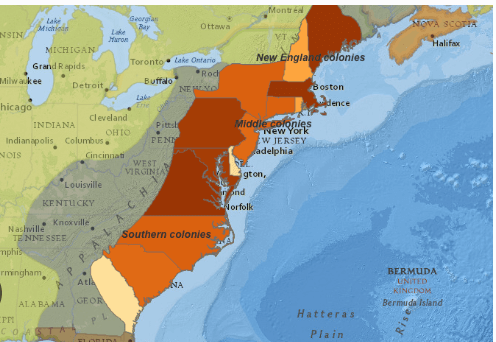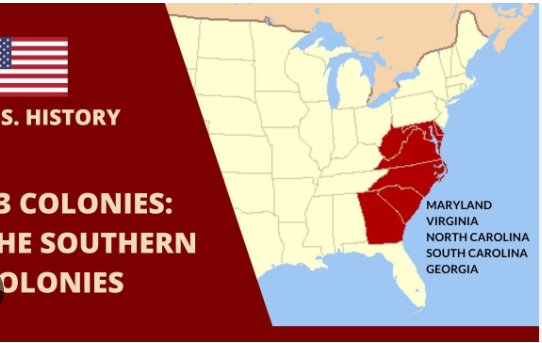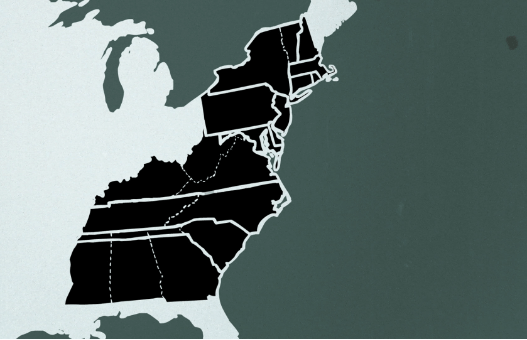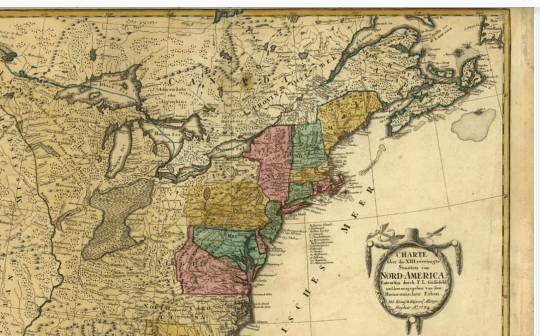The map “1xiy-Ut7usm= 13 Colonies” offers a compelling visual framework for understanding the geographical and cultural distinctions among the original colonies of North America. By categorizing them into New England, Middle, and Southern regions, it underscores the diverse economic practices and social structures that emerged in these areas. Furthermore, the map reflects the complex interactions between the colonists and Native American tribes, setting the stage for pivotal historical developments. What implications did these early relationships have on the path toward independence and the formation of a new national identity?
Overview of the 13 Colonies
The establishment of the 13 colonies marked a significant turning point in the history of North America, laying the groundwork for the future United States.
Diverse settlement patterns emerged, influenced by geography and economic motivations.
Colonial architecture reflected these variations, showcasing regional styles that served both functional and aesthetic purposes.
This interplay of settlement and architecture contributed to the unique cultural tapestry of early American society.

New England Colonies
New England Colonies, comprising Massachusetts, New Hampshire, Rhode Island, and Connecticut, emerged as distinct entities characterized by their unique social, economic, and political structures.
Influenced by Puritan beliefs, these colonies developed strong education systems and community structures. A maritime economy flourished, with a focus on the fishing industry and artisan crafts.
Town meetings fostered civic engagement, while seasonal festivals reflected complex Native relations and women’s roles.
Middle Colonies
Characterized by a diverse population and a blend of agricultural and commercial economies, the Middle Colonies—comprising New York, New Jersey, Pennsylvania, and Delaware—emerged as a crucial hub of cultural and economic activity in colonial America.
Quaker influence promoted religious tolerance, while urban development facilitated trade networks. Ethnic diversity enriched community gatherings, and educational institutions fostered artistic expression amidst evolving social hierarchies and settlement patterns.
Southern Colonies
Although often overshadowed by their Northern counterparts, the Southern Colonies—comprising Maryland, Virginia, North Carolina, South Carolina, and Georgia—played a pivotal role in shaping the economic and social landscape of colonial America.

The plantation system underpinned a rigid social hierarchy reliant on enslaved labor, influencing family structures and regional dialects.
Cultural traditions and colonial education varied significantly, reflecting the complexities of land ownership.
Key Historical Events
The history of the 13 Colonies is marked by a series of key events that significantly influenced their development and the trajectory of what would become the United States.
These events shaped colonial education, reflected regional differences, and established social hierarchies. Military conflicts, changing settlement patterns, and environmental impacts also played crucial roles, while women’s roles, indigenous alliances, and labor systems evolved in response to these dynamics.
Daily Life in the Colonies
In the 13 Colonies, daily life varied significantly across regions, influenced by geography, climate, and cultural practices.
Family dynamics shaped labor roles, while clothing styles reflected social norms.
Education systems differed, impacting children’s leisure activities and community gatherings.

Health practices and religious observances were integral to daily routines, with housing conditions adapting to local resources, demonstrating the diverse tapestry of colonial life.
Economic Activities
The economic activities in the 13 Colonies were primarily driven by agriculture, with each region developing distinct farming practices to suit its climate and soil conditions.
In addition to agricultural production, trade and commerce emerged as vital components of the colonial economy, facilitating the exchange of goods both within the colonies and with international markets.
This interplay between farming and trade laid the foundation for the economic growth and interdependence that characterized colonial life.
Agriculture and Farming Practices
Sustained prosperity in the 13 Colonies was largely dependent on diverse agricultural practices that varied significantly across regions.
Farmers employed crop rotation and sustainable practices to enhance soil conservation while implementing effective livestock management.
Cash crops emerged as economic drivers, supported by agricultural innovations.
Seasonal planting, pest control, and food preservation techniques fortified farming communities, ensuring resilience and adaptability in a dynamic environment.

Trade and Commerce Trends
Trade and commerce in the 13 Colonies were integral to the economic landscape, reflecting a complex interplay of local resources, market demands, and transatlantic connections.
Read More Clipart:9-C_Zorkiqa= Mouse
Colonial trade thrived under mercantile policies, utilizing established shipping routes and diverse trade networks.
Barter systems complemented formal exchanges, while trade regulations influenced the flow of export commodities and import goods, shaping market dynamics and fostering economic competition.
Cultural Influences
Numerous cultural influences shaped the development of the 13 Colonies, reflecting a complex interplay of indigenous traditions, European immigration, and the transatlantic slave trade.
This cultural exchange fostered diverse artistic expression, culinary traditions, and social customs. Language diversity emerged alongside a rich musical heritage, while religious practices and educational influences contributed to distinct architectural styles and folklore origins, enriching the colonies’ communal identity.
Colonial Governance
Colonial governance in the 13 colonies was characterized by a complex interplay between colonial assemblies and legislatures, which varied significantly across different types of colonies.
The distinction between royal and proprietary colonies influenced local governance structures, with each system establishing unique frameworks for political authority and citizen participation.

Understanding these governance models is essential to grasping the broader dynamics of colonial society and its eventual push toward independence.
Colonial Assemblies and Legislatures
Governance in the 13 colonies was characterized by the establishment of various assemblies and legislatures, which played a pivotal role in shaping local political structures.
These bodies, defined by colonial charters, wielded legislative powers, influencing assembly composition and voting rights.
Political representation fostered colonial debates, but governance challenges and factional conflicts often emerged, revealing tensions between colonial aspirations and authoritative constraints.
Royal vs. Proprietary Colonies
The structure of governance in the 13 colonies was further complicated by the distinction between royal and proprietary colonies, each representing different forms of administrative control and authority.
Royal colonies were directly governed by the Crown, emphasizing centralized colonial administration, while proprietary colonies granted land ownership and governance rights to individuals or groups.
This led to varied legal and social structures that reflected differing interests and ambitions.
Local Governance Structures
Within the framework of the 13 colonies, local governance structures played a crucial role in shaping community administration and societal norms.
Read More Map:1jxpuosf7yy= Niagara Falls Canada
Town meetings facilitated citizen participation, allowing for local leadership to emerge and engage in decision-making processes.
Governance models, often outlined in colonial charters, emphasized civic responsibilities and dispute resolution, fostering community engagement and strengthening political organization within the colonies.
Relationships With Native Americans
Throughout the establishment of the 13 Colonies, interactions with Native American tribes varied significantly, shaped by factors such as geography, colonial objectives, and cultural differences.
Tribal alliances formed through trade agreements and resource sharing, while cultural exchanges fostered social interactions.
However, conflicts arose, necessitating conflict resolution strategies and land treaties, which ultimately influenced settlement patterns and diplomatic relations between colonists and indigenous peoples.
Religious Diversity
Interactions with Native American tribes were not the only diverse aspect of life in the 13 Colonies; the religious landscape was equally multifaceted.
Puritan beliefs coexisted with Quaker tolerance, while Catholic missions contributed to the tapestry of faith-based communities.
This environment fostered various religious sects, sparking sectarian conflicts but also encouraging interfaith dialogue, denominational growth, and the rise of evangelical movements, enriching spiritual practices throughout the colonies.
The Road to Independence
Tensions escalated in the 13 Colonies as British governance increasingly clashed with colonial aspirations for autonomy, setting the stage for a revolutionary movement.
Read More Map:1jxpuosf7yy= Niagara Falls
Colonial protests against taxation issues fueled independence movements, while Enlightenment ideas inspired revolutionary sentiment.
Grassroots activism emerged alongside political pamphlets, disseminating revolutionary leaders’ messages.
Despite loyalist opposition, the fervor for freedom solidified the colonies’ resolve towards independence.
Legacy of the Colonies
The legacy of the 13 colonies is evident in both the cultural and political frameworks that continue to shape contemporary American society.
These early settlements established foundational principles of governance, such as representative democracy and individual rights, which have influenced modern political thought.
Additionally, the diverse cultural heritage that emerged from the colonies has left an indelible mark on American identity, contributing to a rich tapestry of traditions and values that persist today.
Cultural Influence Today
Although the thirteen colonies were established in the 17th and 18th centuries, their cultural legacy continues to shape contemporary American society in profound ways.
Cultural exchange has fostered modern traditions and diverse regional identities, while art influence and music styles reflect historical evolution.
Read More Home Controller Troubleshooting: Simple Fixes You Can Do Yourself
Culinary heritage enriches American cuisine, educational systems promote historical reenactments, and social norms reveal the enduring impact of colonial roots on today’s society.
Political Foundations Established
A significant aspect of the legacy of the thirteen colonies is the political foundations they established, which have profoundly influenced the development of American governance.
These colonies adopted diverse political theories and governance models that emphasized individual rights and representative democracy.
Their experiences with self-governance laid the groundwork for future democratic principles, ensuring that the values of liberty and justice remain central to American political identity.
Conclusion
In conclusion, the original 13 colonies played a pivotal role in shaping the early United States, fostering a diverse tapestry of cultures, economies, and political ideologies. While some may argue that regional differences hindered unity, these distinctions ultimately laid the groundwork for a robust national identity. The interactions with Native American tribes, religious diversity, and key historical events further enriched the colonial experience. This complex legacy continues to influence contemporary American society and its enduring values.

